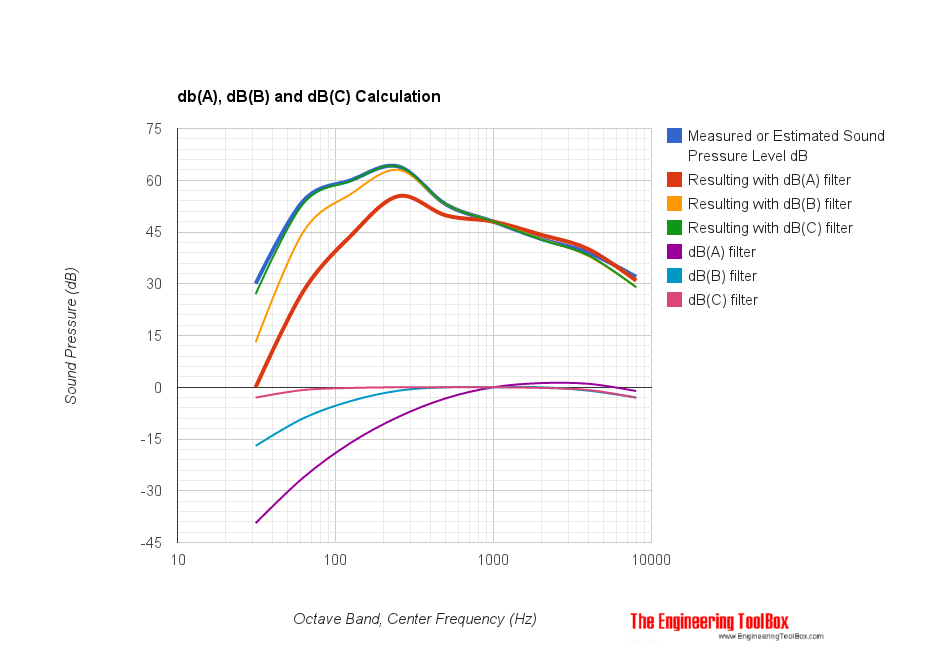Decibel A, B and C
Sound pressure filters that compensates for the hearing sensed by the human ear.
The human ear is more sensitive to sound in the 1 to 4 kHz frequency range than to sound at very low or very high frequencies. Regarding noise - higher sound pressures are therefore more acceptable at lower and higher frequencies than in the mid range.
Knowledge about the human ear is important in acoustic design and sound measurement. To compensate for the human hearing sound meters are normally fitted with filters that adapts the measured sound response to the human sense of sound. Common filters are
- dB(A)
- dB(B)
- dB(C)

Download and print Sound Pressure Level - db(A), dB(B) and dB(C) criteria chart
dB(A)
The decibel A filter is widely used. dB(A) roughly corresponds to the inverse of the 40 dB (at 1 kHz) equal-loudness curve for the human ear.
With the dB(A) filter the sound level meter is less sensitive to very high and very low frequencies. Measurements made with this scale are expressed as dB(A).
Note! The abbreviation dBA or db(A) is not recognized by SI. According to SI - use
"the A weighted sound pressure level is x dB"
or
"LA is x dB"
where
x = the weighted sound pressure level (dB)
Anyway - dBA (or dB(A)) is commonly used.
dB(B) and dB(C)
The decibel C filter is practically linear over several octaves and is suitable for subjective measurements at very high sound pressure levels. The decibel B filter is between C and A. The B and C filters are seldom used.
Comparing dB(A), dB(B) and dB(C)
The A, B and C decibel filters compared:
| Relative Response (dB) | Frequency (Hz) | ||||||||
|---|---|---|---|---|---|---|---|---|---|
| 31.25 | 62.5 | 125 | 250 | 500 | 1000 | 2000 | 4000 | 8000 | |
| dB(A) | -39.4 | -26.2 | -16.1 | -8.6 | -3.2 | 0 | 1.2 | 1 | -1.1 |
| dB(B) | -17 | -9 | -4 | -1 | 0 | 0 | 0 | -1 | -3 |
| dB(C) | -3 | -0.8 | -0.2 | 0 | 0 | 0 | -0.2 | -0.8 | -3 |
Example - Measuring dB(A)
If sound pressure is measured at different octaves the resulting dB(A) sound pressure can be calculated by logarithmic addition.
| Octave band | 1 | 2 | 3 | 4 | 5 | 6 | 7 | 8 |
|---|---|---|---|---|---|---|---|---|
| Center Frequency (Hz) | 62.5 | 125 | 250 | 500 | 1000 | 2000 | 4000 | 8000 |
| Measured Sound Pressure Level (dB) |
54 | 60 | 64 | 53 | 48 | 43 | 39 | 32 |
| db(A) Filter (dB) |
26 | 16 | 9 | 4 | 0 | -1 | -1 | 1 |
| Resulting Sound Pressure Level dB(A) (dB) |
28 | 44 | 55 | 49 | 48 | 44 | 40 | 31 |
The resulting db(A) sound pressure can be calculated by logarithmic adding (adding signals with different strengths) of the sound pressure for each octave.
1. Adding octave band 4 and 5 (check this link)
The difference between octave 4 and 5 is
49 dB(A) - 48 db(A) = 1 dB(A)
=> approximately 2.5 db(A) shall be added to the highest value, resulting in
49 dB(A) + 2.5 db(A) = 51.5 dB(A)
2. The resulting value from octave band 4 and 5 can be added to octave band 3
The difference between octave (4, 5) and 3 is
55 dB(A) - 51.5 dB(A) = 3.5 dB(A)
=> approximately 1.5 db(A) shall be added to the highest value, resulting in
55 dB(A) + 1.5 db(A) = 56.5 dB(A)
3. The resulting sound pressure level in octave 1, 2, 6, 7 and 8 is low compared with octave band (4,5 og 3) and can be neglected.
- The resulting sound pressure level can therefore be estimated to approximately 57.5 dB(A)
db(A), dB(B) and dB(C) Calculation Spreadsheet
Sign in to your Google Account to copy and modify an example spreadsheet with the dB(A), dB(B) and dB(C) calculation and the graph below.
Adjustments to dB(A)
Adjustments to the base level of 40 dB(A):
| Context | Adjustment dB(A) | |
|---|---|---|
| Character of sound | Tones or impulsive noise readily detectable | -5 |
| Tones or impulsive noise just detectable | -2 | |
| Time of day | Evening | -5 |
| Night time | -10 | |
| Neighborhood | Rural and outer suburban areas with little traffic | 0 |
| Suburban areas with infrequent traffic | 5 | |
| Suburban areas with medium density traffic | 10 | |
| Suburban areas with some commerce or industry | 10 | |
| Areas with dense traffic and/or commerce or industry | 15 | |
| City or commercial areas with very dense traffic and/or bordering industrial areas | 20 | |
| Industrial areas and/or extremely dense traffic | 25 | |




